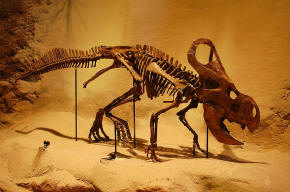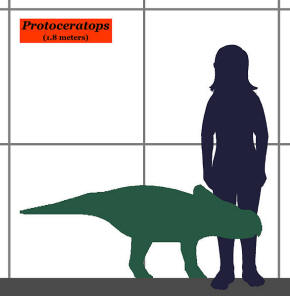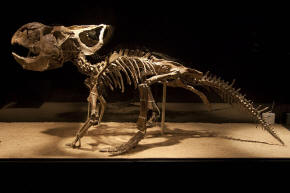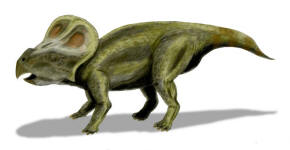|
Description
Protoceratops
was a quadrupedal dinosaur
that was partially characterized by its distinctive
neck frill at the back
of its skull. The frill itself contained two large parietal fenestra (holes
in the frill), while its cheeks had large
jugal bones. The exact
size and shape of the neck frill varied by individual; some specimens had
short, compact frills, while others had frills nearly half the length of the
skull. The frill consists mostly of the
parietal bone and
partially of the
squamosal. Some
researchers attribute
the different sizes and shapes of these bones to
sexual dimorphism, as
well as the age of the specimen, at the time of death.
Protoceratops
was approximately 1.8 meters (6 ft) in length and 0.6 meters (2 ft) high at
the shoulder. A fully grown adult would have weighed less than 400 pounds
(180 kg). The large numbers of specimens found in high concentration suggest
that Protoceratops
lived in herds.
Protoceratops
was a relatively small dinosaur with a proportionately large skull. Despite
being herbivorous, Protoceratops
appears to have had muscular jaws capable of a powerful bite. These jaws
were packed with dozens of teeth, well suited for chewing tough vegetation.
The skull consisted of a massive frontal beak, and four pairs of
fenestrae (skull
openings). The foremost hole, the
naris, was considerably
smaller than the nostrils seen in later genera.
Protoceratops had large
orbits (the holes for
its eyes), which measured around 50 millimeters in diameter.
Discovery
and species
Photographer J.B.
Shackelford discovered the first specimen of
Protoceratops in the Gobi desert, (Gansu,
Inner Mongolia), as
part of a 1922 American expedition looking for human ancestors. No early
human fossils were found, but the expedition, led by
Roy Chapman Andrews,
collected many specimens of the Protoceratops
genus, along with fossil skeletons of theropods
Velociraptor,
Oviraptor, and
ceratopsid
Psittacosaurus.
Walter Granger and
W.K. Gregory formally
described the
type species,
P. andrewsi in 1923, the
specific name in honor of Andrews. The fossils hail from the
Djadochta Formation and
date from the
Campanian
stage of the Late Cretaceous (83.5 to
70.6 million years ago).
Researchers immediately noted the importance of the
Protoceratops finds, and
the genus was hailed as the "long-sought ancestor of
Triceratops". The
fossils were in an excellent state of preservation, with even the
sclerotic rings
(delicate occular bones) preserved in some specimens.
In 1971, a fossil was found that
had a
Velociraptor clutched
around a Protoceratops
in
| For detailed images of the Velociraptor/Protoceratops fighting
fossil, please visit the
Black Hills Institute website. They sell reproductions of
this fossil. |
Mongolia. It is believed that they died simultaneously, while fighting,
when they were either surprised by a sand storm or buried when a sand dune
collapsed on top of them.
In 2001, a second valid species,
P. hellenikorhinus,
was named from the
Bayan Mandahu Formation
in
Inner Mongolia, China and also dates
from the Campanian stage. It was
notably larger than P. andrewsi,
had a slightly different frill, and had more robust
jugal horns. The arch
of bone over its nostrils had two small nasal horns, and there were no teeth
at the front of the snout.
Paleobiology
Reproduction
In the 1920s, Roy Chapman Andrews
discovered the first known fossilized dinosaur
eggs, in the Gobi Desert of
Mongolia. Each egg was about 8 inches long, and newborn hatchlings estimated
to have been about a foot in length. Due to the proximity and abundance of
Protoceratops,
these eggs were believed at the time to belong to this genus.
The contemporary theropod
Oviraptor was thought
to consume Protoceratops
eggs due to the discovery of an Oviraptor
skeleton present at a nest. The skull was crushed, and it was speculated
that the injury was received by an angry
Protoceratops mother defending her nest from the
predator.
However, in 1993 Norrell
et al. discovered an
embryo inside a supposed Protoceratops
egg. This embryo, upon close examination, turned out to actually belong to
Oviraptor itself.
The original find actually represented
Oviraptor brooding behavior.
Daily
activity patterns
The large eyes of
Protoceratops has been
suggested as evidence for a nocturnal lifestyle.
However, subsequent comparisons between the
scleral rings of
Protoceratops and modern
birds and reptiles have indicated a more
cathemeral lifestyle,
being active throughout the day during short intervals. This suggests that
the fight between Protoceratops
and the primarily nocturnal Velociraptor
indicated by the fighting specimens may have occurred at twilight or under
low-light conditions.
Classification
Protoceratops
was the first named protoceratopsian and
hence gives its name to the family
Protoceratopsidae, a
group of herbivorous dinosaurs that were too advanced to be psittacosaurids,
but too primitive to be ceratopsids. The group is characterized by their
similarities to the Ceratopsidae but with
more
cursorial limb
proportions, generally smaller frills, and lack of large horns.
Return to the
Old Earth Ministries Online Dinosaur
Curriculum homepage.

Shopping
Bay
State Replicas - Skeleton, skull, hand
Black
Hills Institute - Velociraptor vs. Protoceratops fighting dinosaurs
|



